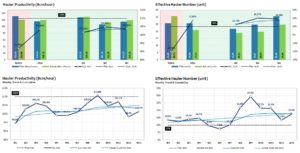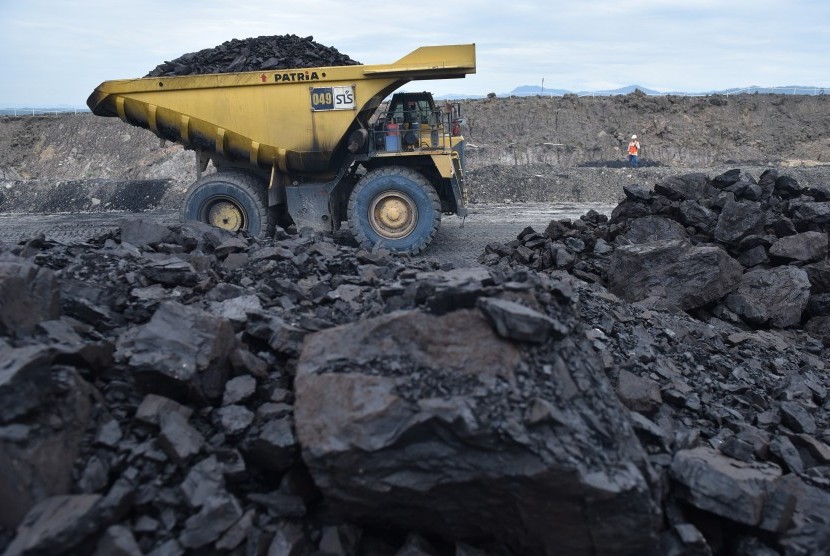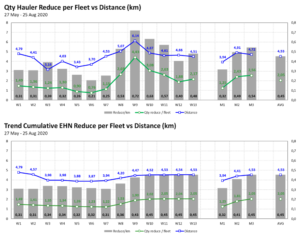Minimising operational and maintenance costs is a key business driver in mining. In its most recent blog post, Hexagon Mining says the challenge is doing this in a stressful, ever-changing environment. “At the front line are dispatchers responsible for scheduling and assigning work orders to operators and equipment. Their decision-making keeps a fleet running efficiently. The multitude of fleet management systems available on the market shows that mines are hungry to improve their operational efficiency.”
OP Pro is Hexagon’s flagship solution for fleet management. The company says it combines hardware and software for unparalleled insight into production. The latest version, OP Pro 3.0 introduces an all new user interface and experience, as well as peer-to-peer communications to ensure that there are no gaps in network coverage. In May 2020, Hexagon conducted a three-month proof of concept (POC) trial with dispatchers from coal mining major Adaro Indonesia’s PT Saptaindra Sejati (SIS) mining contractor using the newest advancements in OP Pro, in particular the Optimizer tool. OP Pro Optimizer is a real-time production optimization tool that helps keep trucks on target. The tool takes a wide range of user and system defined parameters to calculate optimal assignments. This includes shovel and material priorities, capacities, road networks, restrictions, queue times and more.
“OP Pro 3.0 brings even more functionality including an enhanced module to manage breaks, detailed logs to show what parameters were considered in calculations and other ease-of-use improvements. Over the course of the three-month trial, Adaro reduced the number of haul trucks per fleet by two, increased productivity from 91.88% to 103.44% of the plan, and reduced loader hangtime to seven minutes.”
While many factors affect efficiency including operational conditions, infrastructure and dispatcher skill, Hexagon Mining believes that the data collected in this trial shows some of the real benefits of implementing Optimizer. Production optimisation is a differentiating factor from other FMS products.
Mine Dispatch (FMS) Section Head at PT Saptaindra Sejati, Henry Johannes Sirait stated: “By using the Optimizer feature in the MineOp Pro system, we prove that with this system we can reduce the use of the number of Dump Trucks (Effective Hauler Number) by two units for each fleet with an average haul distance of 4.53 km; or equivalent to the reduction of 0.45 dump trucks for each kilometre. The results we get, of course, will not always be the same as operational conditions in other mining areas, but this can be a general reference for the benefits of the FMS system. And besides the Optimizer feature itself, of course there are many things that influence this achievement, such as good operational conditions and the performance of the dispatchers.”
The trucks that SIS used during this POC were Caterpillar 785 and Komatsu HD1500 units which have the same 150 ton payload. And the loaders are Hitachi EX3600 and Liebher R 9400. “Prior to the implementation of this POC, our hauler productivity achievement was 91.88% of the plan, and after POC the hauler productivity was 103.44%. The achievement of increasing hauler productivity is in line with the data on reducing the effective hauler number.”

Finally Sirait said that the POC also focused on improving hanging no hauler time. “The target is to reduce the hanging no hauler time (accumulated) to 7 minutes per hour (min/hour) through the implementation of the MineOperate Pro Optimizer. And the value of 7 minutes is a challenge to our dispatch operational team and Hexagon team. For your information, our ideal target is 10 minutes per hour. By reducing the hanging no hauler time, it will automatically increase the loader’s effective working hour and production achievement. During the three months of conducting this trial/POC, we managed to get a hanging no hauler of 7.34 min/hour or 95.40% of the target (7 min/hour) or an achievement of 136.29% of the ideal target (10 min/ hour). Before implementing POC, our actual hanging no hauler achievement was 12.60 min/hour. From the graph in Figure 1, it can be seen that there was a decline in the 2nd month, then there was an improvement in the 3rd month and this is also seen in the weekly trend chart in Figure 2. The best achievement on average was in the 3rd month which was 6.83 min/hour or 102.43% of the target.”
He concludes: “Setting the right Optimizer parameters to maintain the balance of haulage capacity and load capacity, increasing dispatcher/mine controller competence, utilising real time data reports by systems and developed custom reports for evaluation and analysis, good infrastructure, supportive management & vendors are the keys to successed Optimizer FMS’s implementation.”












